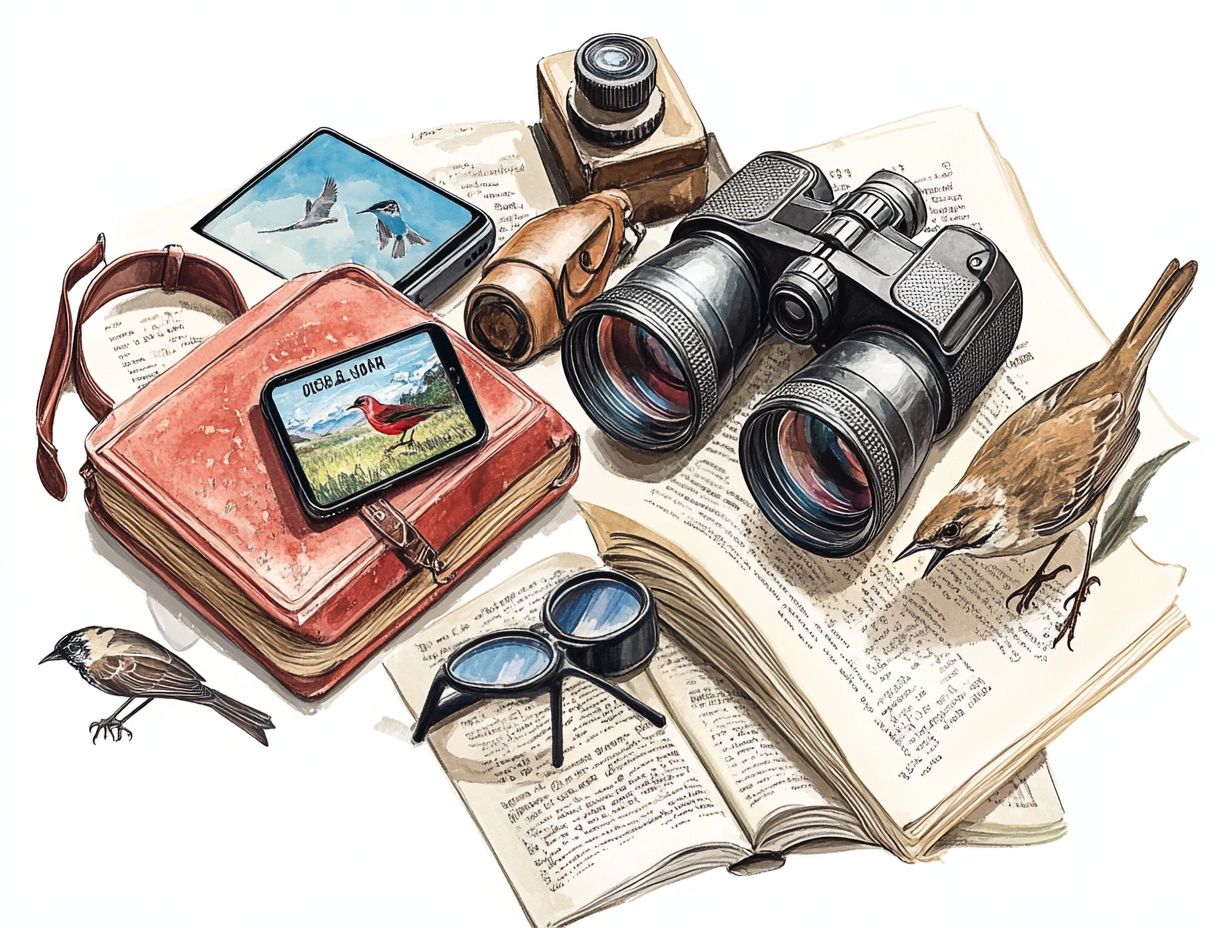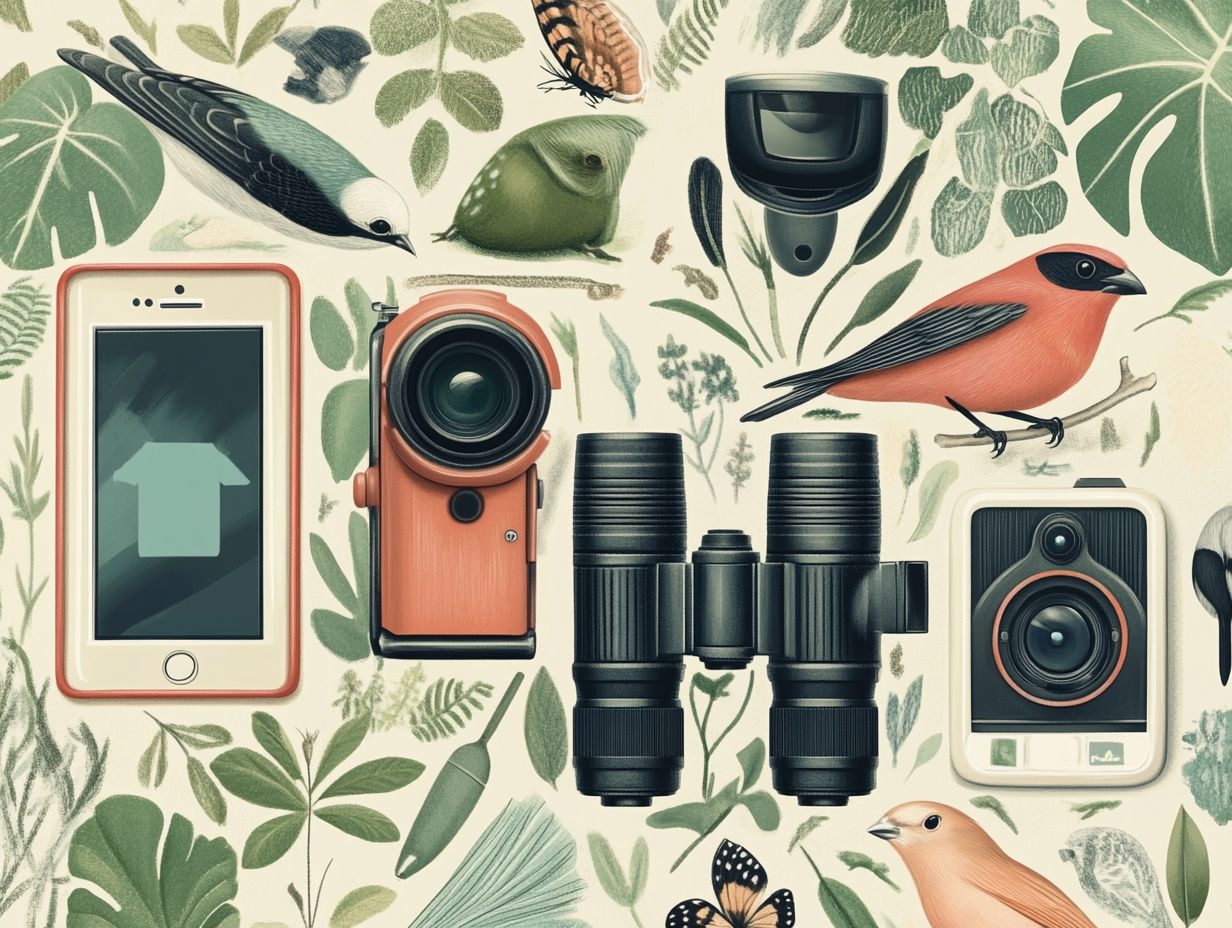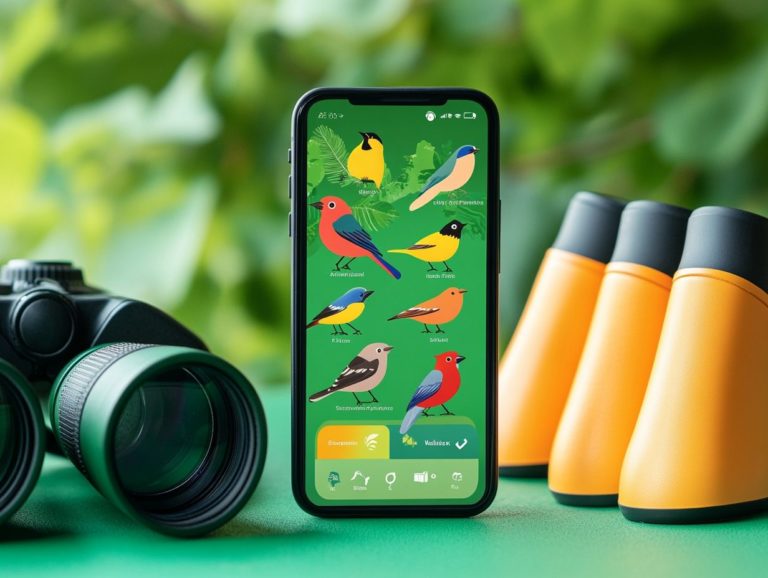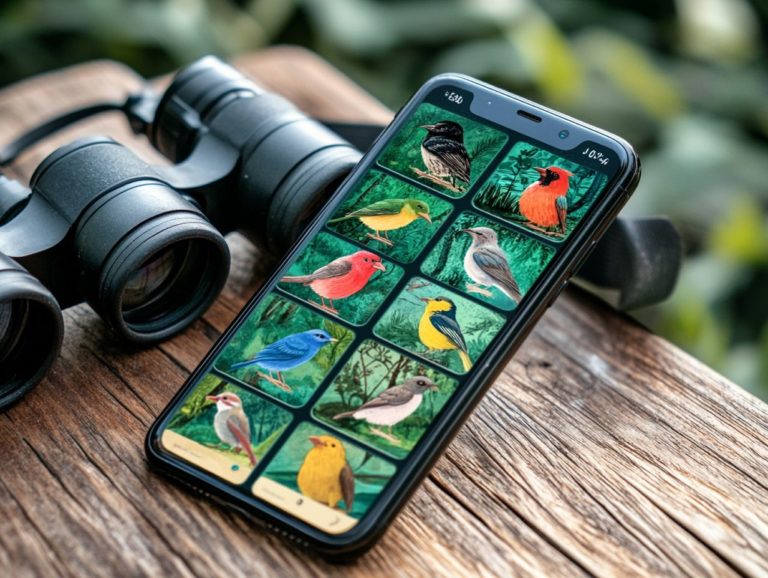The Evolution of Birding Technology
The world of birding has undergone a remarkable transformation over the years, driven by technological advancements.
You ve witnessed the evolution from simple observation techniques to the sophisticated binoculars and scopes that define today s birding experience. Each innovation has profoundly shaped how enthusiasts like you connect with nature.
Digital resources and apps have revolutionized the hobby, making birding more accessible than ever before. As you delve into the past, present, and future of birding technology, you ll uncover the significant impact these changes have had on the community, along with the ethical considerations that come into play.
Embark on this captivating journey through the evolution of birding technology and discover the myriad ways it enriches your experience in the great outdoors.
Contents
- Key Takeaways:
- The History of Birding Technology
- The Impact of Digital Technology on Birding
- The Future of Birding Technology
- How Birding Technology has Changed the Hobby
- Frequently Asked Questions
- What is the history of birding technology?
- How has the development of cameras impacted birding?
- What role have audio recordings played in the evolution of birding technology?
- How have apps and online resources changed the way birders interact with technology?
- What advancements have been made in binoculars for birding?
- What is the future of birding technology?
Key Takeaways:

- Technological advancements have greatly impacted birding, from early methods like using decoys to modern resources like online apps.
- The future of birding technology is predicted to bring even more innovations, but ethical concerns must also be considered.
- The evolution of birding technology has made the hobby more accessible and popular, but it has also sparked controversies and challenges.
The History of Birding Technology
The history of birding technology is intertwined with the very origins of birdwatching, capturing the evolution of the birding community, especially since the landmark publication of Kingbird Highway in July 1997, which inspired many young birders. As we look ahead, exploring the future of bird field guides in the digital age will be essential for the next generation of birdwatchers.
Over the years, you ve witnessed significant advancements in how bird enthusiasts identify and observe various species. Organizations like the American Birding Association and the National Audubon Society have played pivotal roles, championing conservation efforts and environmental monitoring.
Their dedication has enriched the birding experience for people of all ages, ensuring that this passion continues to thrive.
Early Methods of Birding
Early birding methods relied heavily on your observational skills and printed field guides, with Roger Tory Peterson’s influential works leading the charge in effective bird identification for enthusiasts like you.
These foundational practices highlighted the significance of keen observation, enabling you to notice the subtle nuances in plumage, behavior, and song.
The introduction of field guides revolutionized your experience, making it possible for individuals from all walks of life to engage with the wonders of nature.
Peterson’s groundbreaking publication, A Field Guide to the Birds, not only showcased accurate illustrations but also offered practical tips for identifying various species.
His innovative approach transformed birding into a serious pastime, inspiring you and countless others to explore the avian world with both passion and precision.
This evolution, in turn, cultivated a vibrant community of devoted bird watchers who eagerly shared knowledge and experiences, further enriching your practice.
Advancements in Binoculars and Scopes
The advancements in binoculars and scopes have truly transformed the birdwatching experience, allowing you to observe a remarkable diversity of species from a comfortable distance.
These innovations also include features like advanced lens coatings, which significantly enhance the amount of light that passes through the lenses and contrast.
This means you can appreciate details with exceptional clarity, even in those tricky low-light conditions.
Modern binoculars often offer higher magnification while remaining compact and lightweight, making them a breeze to carry on your long hikes.
Thanks to the introduction of image stabilization technology (which reduces blurriness caused by hand movement), the annoying blur from a shaky hand is now a thing of the past, giving you sharper views of those elusive birds.
All these enhancements not only help you identify birds more accurately but also elevate your overall outdoor experience, making each moment spent in nature even more enjoyable.
The Impact of Digital Technology on Birding

The rise of digital technology has significantly reshaped the birding community, marking the dawn of a new generation of digital birders.
Now is the time to harness resources like eBird and social media to supercharge your birding experiences and cultivate meaningful connections with fellow enthusiasts.
Dive into the world of birding technology today and discover transitioning from field guides to birding apps to see how it can transform your outdoor adventures!
Online Resources and Apps for Birding
Online resources and apps like eBird and various field guide applications have revolutionized bird identification and tracking. This makes it easier for both novice and experienced birders to engage with their passion.
These tools also boast user-friendly interfaces that allow you to enter data in real time. You can log your sightings while contributing valuable information to larger environmental studies.
Equipped with features such as audio recordings of bird calls, visual identification guides, and community forums, these apps enhance your learning experience and foster a vibrant community among fellow bird enthusiasts.
Organizations like the Cornell Lab of Ornithology play a crucial role in developing these resources. They ensure you have access to scientifically validated data essential for effective conservation efforts and deepening your understanding of bird populations in their natural habitats. This shapes the future of the birding world.
The Future of Birding Technology
The future of birding technology is on the brink of thrilling advancements. Get ready for exciting innovations that will change how you experience birdwatching, especially with the introduction of AI-powered birding tools.
Predicted Advancements and Innovations
Predicted advancements in AI-powered birding technology are set to revolutionize how you engage in observation and inference. This will make bird identification more accurate and accessible than ever before.
Imagine smart optics that seamlessly blend high-resolution cameras with real-time data analysis. You will be able to capture stunning images of birds while receiving instantaneous identification suggestions.
Picture augmented reality applications that enable you to overlay digital information onto your surroundings. This enhances your understanding of bird behavior and habitat.
Machine learning models are expected to continually refine their accuracy, adapting to regional variations and the dynamics of evolving bird populations.
Together, these innovations promise to elevate your birding experience. They offer deeper insights, foster connections within the community, and encourage broader participation in conservation efforts.
Potential Ethical Concerns

As birding technology advances, you may encounter potential ethical concerns regarding conservation efforts and the impact of habitat loss on bird populations.
The introduction of cutting-edge tools, like drones and high-resolution cameras, offers you an exhilarating look into avian life. However, it also prompts important questions about how these advancements affect bird behavior and stress levels.
As social media becomes a go-to platform for sharing your birding experiences, privacy issues take center stage. Revealing sensitive locations can lead to overexploitation of popular bird species and habitats.
These considerations highlight the necessity for the birding community to embrace responsible practices. By prioritizing wildlife welfare and habitat preservation, you can ensure that the joy of birding does not come at the expense of the very species you cherish.
How Birding Technology has Changed the Hobby
The evolution of birding technology has transformed your birding experience. It enables you to connect seamlessly with fellow enthusiasts through social media platforms and local birding clubs, all supported by the science behind bird watching apps.
This has fostered a vibrant community, bringing together both young birders and seasoned experts. This enriches your journey in the world of avian observation.
Increased Accessibility and Participation
Increased accessibility to birding technology has given you, the young birder or newcomer, the power to dive into this hobby. This makes your birding experience fun and welcoming, opening doors to new adventures!
This transformation has been largely fueled by innovative tools like mobile apps and digital field guides, which simplify the identification process and elevate your overall experience. A treasure trove of educational resources including online courses, webinars, and insightful blogs provides you with the knowledge needed to thrive in your birding journey.
Birding clubs play a crucial role in fostering a sense of community, offering mentorship and support to you, the new enthusiast. They organize group outings that help you develop skills and nurture your passion.
As a result, the synergy of technology, education, and community has created a vibrant ecosystem for birdwatching, warmly welcoming a diverse array of participants like yourself, including avid followers of Watching Birds and enthusiasts of Roger Tory Peterson s work.
Challenges and Controversies
Despite the numerous benefits that technological advancements bring, challenges and controversies within the birding community continue to thrive. These often center around ethical birding practices and the implications of sharing on social media.
As you increasingly turn to platforms like Instagram and Twitter to showcase your sightings, it raises important questions about dependence on likes and shares and the risk of misinformation. You may find yourself grappling with ethical dilemmas when reporting rare species; the excitement of a sighting can unintentionally disturb habitats, as increased foot traffic disrupts nesting grounds.
There s a growing concern that the instant gratification offered by social media can overshadow the significance of responsible birdwatching. This ultimately affects conservation efforts and shifts the focus from protecting avian populations to the mere pursuit of capturing the perfect shot.
Frequently Asked Questions

What is the history of birding technology?
The earliest form of birding technology was the use of binoculars and field guides, dating back to the 18th century. As technology advanced, so did birding equipment, with the introduction of cameras, audio recordings, and bird watching apps for identification.
How has the development of cameras impacted birding?
The development of cameras has greatly enhanced birding, allowing for better documentation of sightings and the ability to zoom in on birds for more accurate identification. It has also made it easier to share and compare sightings with other birders.
What role have audio recordings played in the evolution of birding technology?
Audio recordings have been used in birding since the late 19th century, with the invention of the phonograph. They have allowed for the documentation and study of bird songs and calls, as well as aiding in bird identification in the field.
How have apps and online resources changed the way birders interact with technology?
With the rise of smartphones, apps and online resources have become popular tools for birders. These technologies provide access to bird identification guides, birding hotspots, and even real-time tracking of bird sightings.
What advancements have been made in binoculars for birding?
Binoculars have gone through many advancements since their initial use in birding. High-quality optics, lightweight materials, and waterproof designs have greatly improved the birding experience for those using binoculars.
What is the future of birding technology?
The future of birding technology is exciting and full of possibilities, with innovations just around the corner. Virtual and augmented reality may soon allow birders to experience birding in a whole new way, and advancements in the study of sounds made by animals and remote sensing may provide new tools for studying and monitoring bird populations, potentially including species such as the Berylline Hummingbird.






